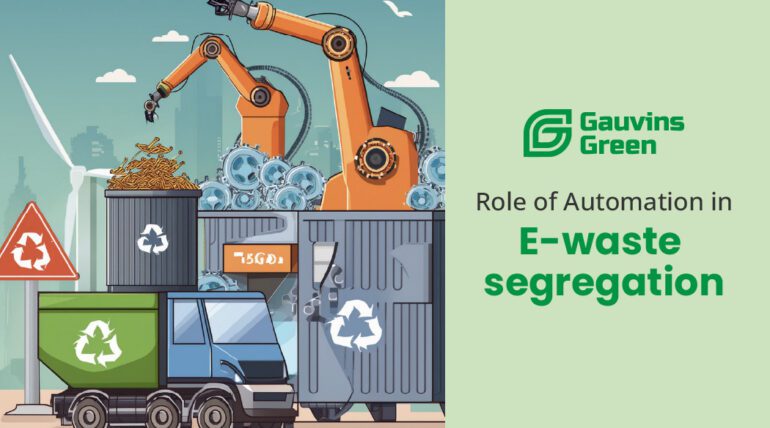In today’s digital age, electronic waste, or e-waste, has become a significant environmental concern worldwide. With the rapid advancement of technology, the proliferation of electronic devices has led to a corresponding increase in e-waste generation. Proper segregation and recycling of e-waste are essential to mitigate its environmental impact and promote sustainability. In recent years, automation has emerged as a game-changer in e-waste segregation, revolutionizing traditional methods and offering numerous benefits to both businesses and the environment.
Benefits of Automation in e-Waste Segregation:
Automation offers several key advantages in e-waste segregation. Firstly, it significantly improves efficiency by streamlining the sorting process, reducing manual labor, and increasing throughput. Automated systems can quickly and accurately identify different types of e-waste, enabling faster and more precise segregation. Additionally, automation enhances safety by minimizing human exposure to hazardous materials commonly found in e-waste, thereby reducing the risk of occupational hazards and health issues among workers.
Furthermore, automation enables better resource utilization and cost savings by optimizing material recovery and minimizing waste. By efficiently segregating e-waste components, valuable resources such as metals, plastics, and rare earth elements can be recovered and recycled, reducing the need for raw materials and promoting circular economy principles. Overall, automation plays a crucial role in improving the sustainability and environmental performance of e-waste recycling operations.
Case Study of Gauvins Green:
Gauvins Green, a leading e-waste recycling company in India, exemplifies the transformative impact of automation in e-waste segregation. By leveraging state-of-the-art technology and innovative solutions, Gauvins Green has revolutionized its e-waste recycling processes, setting new standards for efficiency, accuracy, and environmental sustainability.
One of the key areas where automation has made a significant difference for Gauvins Green is in its e-waste segregation process. Through the implementation of advanced automated sorting systems, Gauvins Green has been able to enhance the efficiency and accuracy of its segregation operations. These systems utilize cutting-edge technologies such as machine learning and computer vision to identify and separate different types of e-waste components with precision and speed.
As a result, Gauvins Green has been able to significantly increase its processing capacity while maintaining high levels of quality and reliability. The company’s automated segregation process ensures that valuable materials are recovered efficiently, maximizing resource recovery and minimizing waste. Moreover, automation has improved workplace safety by reducing the need for manual handling of e-waste and minimizing exposure to hazardous substances.
Technological Innovations in e-Waste Segregation:
Gauvins Green continues to push the boundaries of technological innovation in e-waste segregation, introducing cutting-edge solutions to address emerging challenges and improve operational efficiency. One notable innovation is the integration of blockchain technology into its e-waste management system.
Blockchain technology provides a transparent and immutable record of e-waste transactions, ensuring traceability and accountability throughout the recycling process. By leveraging blockchain, Gauvins Green can track the movement of e-waste from collection to processing, providing stakeholders with real-time visibility into the status and location of their materials. This enhances trust and transparency in e-waste management, facilitating compliance with regulatory requirements and promoting responsible recycling practices.
Additionally, Gauvins Green has invested in the development of automated robotic systems for e-waste disassembly and sorting. These robotic systems use advanced sensors and algorithms to identify and separate different e-waste components with high precision and efficiency. By automating labor-intensive tasks, such as dismantling and sorting, these robotic systems reduce processing time and labor costs while improving overall process efficiency.
Challenges and Solutions in e-Waste Segregation:
Despite the numerous benefits of automation in e-waste segregation, several challenges persist in the industry. One of the primary challenges is the need for proper segregation equipment and infrastructure. Many recycling facilities lack access to advanced automated sorting systems and rely on manual methods, leading to inefficiencies and inaccuracies in the segregation process. To address this challenge, companies like Gauvins Green are investing in the development and deployment of state-of-the-art segregation technologies, making automation more accessible and affordable for recycling facilities worldwide.
Another challenge is the importance of employee training and education in utilizing automated systems effectively. While automation streamlines the segregation process, it also requires skilled operators to oversee and maintain the equipment. Gauvins Green recognizes the importance of investing in workforce development and provides comprehensive training programs to ensure that employees are equipped with the knowledge and skills to operate automated systems safely and efficiently.
Furthermore, the development of effective segregation protocols is essential to maximizing the benefits of automation in e-waste recycling. Gauvins Green has implemented robust protocols for sorting and processing different types of e-waste, ensuring optimal resource recovery and environmental sustainability. These protocols include guidelines for identifying and categorizing e-waste components, as well as procedures for handling and disposing of hazardous materials safely.
Conclusion and Call to Action:
In conclusion, automation plays a pivotal role in transforming e-waste segregation, offering numerous benefits in terms of efficiency, accuracy, and environmental sustainability. Through technological innovations and strategic investments, companies like Gauvins Green are leading the way in revolutionizing e-waste recycling processes, setting new standards for excellence in the industry.
As we continue to confront the challenges of e-waste pollution and resource depletion, it is imperative that we embrace automation and other innovative solutions to improve the efficiency and effectiveness of e-waste recycling. By supporting initiatives that promote automation and investing in sustainable recycling practices, we can collectively work towards a cleaner, greener future for generations to come.


